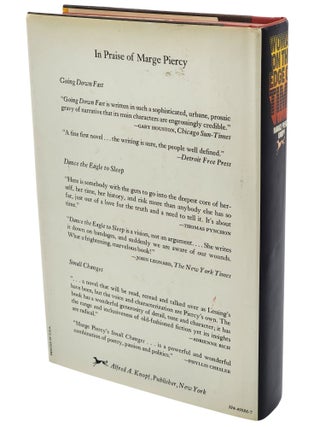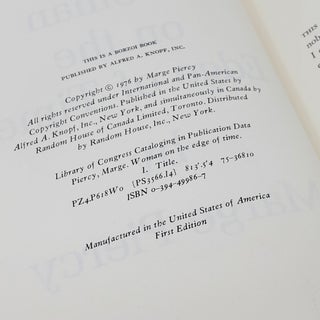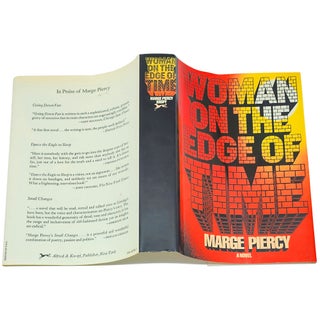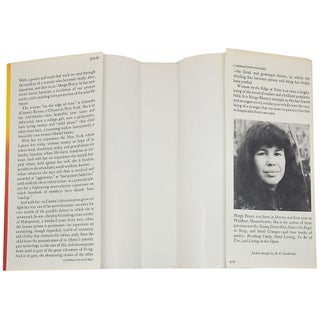Woman on the Edge of Time
Marge Piercy's Woman on the Edge of Time is a groundbreaking work in feminist dystopian literature. First published in 1976, the novel balances on the edge of utopia and dystopia to delve into the systemic oppression faced by women, especially those of marginalized communities. The story follows Consuelo "Connie" Ramos, an impoverished Mexican-American woman who navigates a brutal mental health system that seeks to strip her of her autonomy. Through her connection with Luciente, a figure from a potential utopian future, the novel contrasts the oppressive society of 1970s America with an idealistic future that dismantles patriarchy, racism, and classism. First editions are surprisingly difficult to find, especially in nice condition.
Hardcover. First Edition, First Printing. New York: Alfred A. Knopf, 1976. Pringle, Science Fiction: The 100 Best Novels (81). ISBN: 0394499867. #10841.
Near fine in near fine dust jacket.








In the realm of feminist dystopian literature, Marge Piercy's Woman on the Edge of Time holds a special place as an early but timeless examination of gendered oppression, mental health, and societal transformation. Written in 1976, the novel presents an unforgettable protagonist, Consuelo "Connie" Ramos, a Mexican-American woman institutionalized in a New York mental hospital. Connie's life serves as a microcosm of the societal pressures and prejudices that women, particularly those from marginalized communities, have to endure. The oppressive regime she faces in the mental institution stands as a symbol for broader societal control mechanisms that strip individuals of their autonomy, particularly targeting women and minority groups.
The novel's brilliance lies in its intricate weaving of two contrasting timelines—a dystopian present and a possible utopian future. Through her telepathic conversations with Luciente, Connie explores a future society that addresses issues such as patriarchy, racism, homophobia, and economic disparity. This society is presented as an achievable outcome of collective struggle and social activism. By doing so, Piercy argues for the feasibility of such a society and also stresses the necessity of personal and collective action to achieve it.
However, Piercy does not offer an easy escape into a utopian dream. The novel boldly presents another, more disturbing future—a consumerist, hyper-capitalist, environmentally compromised society that represents the darkest implications of current trajectories. Here, Piercy challenges the reader to understand that the future is not set; it is a battleground of conflicting ideologies and actions, and complacency could lead us into a dystopian nightmare.
Piercy's novel embodies deep-rooted feminist perspectives. The struggle against a paternalistic medical system, the reimagining of maternal roles, and the destruction of gender binaries in the utopian world all align with feminist thought. Piercy’s narrative also includes LGBTQIA+ representations, stressing the importance of queer equality in her feminist discourse.
Woman on the Edge of Time is a seminal work in feminist dystopian literature, intricately tying the personal struggles of its protagonist with broader societal issues. By oscillating between utopian and dystopian visions of the future, Piercy explores the complexities of systemic oppression while also inspiring hope and activism, which can be seen as a rejoinder to mainstream dystopian works that failed to envision a future beyond totalitarian regimes.